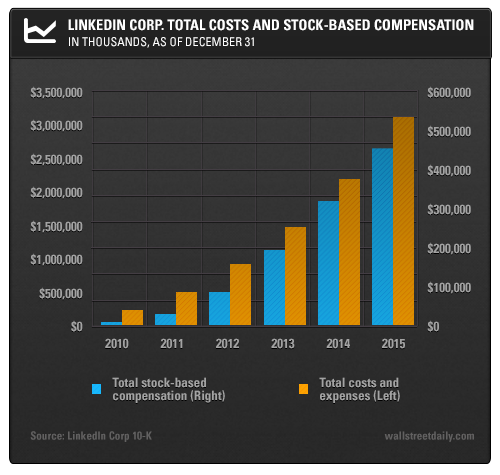Next week, the quarterly earnings from LinkedIn (NYSE:LNKD) – among other tech stocks – will finally become public knowledge.
Once the market responds to the report, it appears logical that the resulting stock prices would represent fair market value.
This cause and effect, however, is not so simple. The legitimacy of the market reaction will depend on how earnings are measured.
Operating Within the Margins
Many analysts value a company based on its “operating margin,” which is a ratio used to measure a company’s pricing strategy and operating efficiency.
In other words, it’s a measurement of what proportion of a company’s revenue remains after paying operating or variable costs.
Operating costs include paid employee wages, research and development (R&D), and raw materials.
When a company wants to increase its operating margin –also known as “profit margin” – it will aim to increase its bottom line by cutting expenses while ensuring any cuts don’t affect business operations or the firm’s ability to compete with other similar companies.
Operating margins, for any specific time period, can be calculated using the following formula:
Operating Margin = Operating Income / Net Sales
The resulting ratio gives analysts an idea of how much a company makes – before interest and taxes – on each dollar of sales.
Generally speaking, the higher the company’s operating margin, the better off the company. If the margin is increasing, then the company is earning more per dollar of sales.
And if it’s earning more, then it’s better positioned to satisfy its creditors, create value for its shareholders, and be able to pay its fixed costs – such as interest on debt.
But there’s one cost that’s a bit iffy when it comes to evaluating a company’s value, and that’s compensation paid in stocks or employee stock option plans (ESOPS).
And LinkedIn isn’t the only organization that uses this practice – other tech companies such as Twitter Inc (NYSE:TWTR), Yahoo! Inc (NASDAQ:YHOO), and Alibaba (NYSE:BABA) are known to depend on stock to compensate their employees.
In some cases, they’re particularly generous.
Not surprisingly, a growing company such as LinkedIn has faced greater costs over the years as its business has grown. But so has the growth of its stock options.

In fact, in 2014, the $319 million, LinkedIn paid in ESOPs represented 14% of its revenue. By 2015, that percentage had increased to 17%, the equivalent of $510 million in stock.
The Limitations of Operating Margin
Here’s where this gets tricky.
Just like any ratio used to gauge a company’s performance and profitability, calculating a company’s operating margin comes with an important set of limitations that any prudent analyst or investor would benefit from considering.
During boom periods in particular, Wall Street focuses on a company’s operating results, but it tends to exclude the expense of ESOPS.
The expenses that fall under operating costs are often designated as either “cash expenses” or “non-cash expenses,” with the latter not requiring a cash outlay. In the case of employee stock options, there’s no cash outlay until the options are exercised.
Even if and when the options are exercised, the outlay to the employee would be considered a non-recurring cash flow, similar to cash paid out in a lawsuit settlement. These, too, are excluded from the operating margin calculation, as they don’t represent a company’s true operating performance.
As such, some analysts claim that by not including ESOPS in with other costs, the quality of a company’s earnings can be distorted.
The Bright Side of ESOPs
The upside with ESOPS, it’s argued, is that they provide an opaque yet added value to a company’s stock.
For the most part, the investment community views ESOPs favorably, since their issuance should align the interest of the employees with the company’s performance, and incentivize those employees to grow their own personal wealth.
Essentially, an employee may work harder or more efficiently with an end game of making call options in-the-money.
Some argue that granting too many ESOPS leaves employees betting too much of their compensation on the stock.
Theoretically, anyone – employee or not – can buy LinkedIn calls to capture that upside and, instead, focus compensation on salary.
But most ESOP expirations are 10 years out, as they’re structured to keep the owners employed with the company for the long term.
Ten-year calls aren’t available on the open market. The longest expiration exchange-traded equity options (known as LEAPS) typically expire no more than two years out.
Suppose an investor wants to buy at-the-money calls with the furthest expiration date. A $115 call expiring January 19, 2018 (only a year and a half out) as of the close of April 18 has an offer price of $27.95. So, if 20 calls are purchased, representing 2,000 shares, this investor would need to lay out $55,900 (and that doesn’t even include brokerage fees).
Brokers normally require investors to put up only 75% of that amount for margin maintenance purposes. But should the value of the options decrease, there may be a margin call – typically if the time to expiration is over nine months.
As we know with options, time is money, and the further out in time the expiration, the greater the premium. Think about the value added in those additional eight and a half years.
Pay Attention
Watch out for next week’s quarterly earnings from LinkedIn, but don’t forget to take into consideration the amount of stock grants that the company will pay employees relative to its earnings.
ESOPS are of particular interest to Wall Street now, especially since listed tech companies have had a precarious time in the markets recently.
LinkedIn has already projected lower growth for 2016, resulting in a steep drop in its stock price, while Yahoo is currently up for sale.
But don’t forget the added value that those hard-working ESOP holders bring to the table.
